英语构词法练习题基础篇培训资料
- 格式:doc
- 大小:23.50 KB
- 文档页数:3
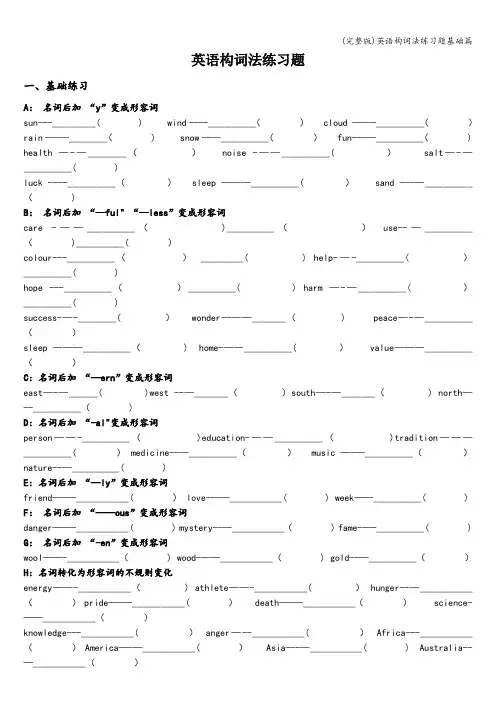
英语构词法练习题一、基础练习A:名词后加“y”变成形容词sun---_________( ) wind -—-__________() cloud ——-__________()rain -——________( ) snow --—__________() fun-——__________( ) health —-—________()noise -——__________( )salt—-—__________( )luck -—-__________() sleep ———__________( ) sand -——__________( )B:名词后加“—ful" “—less”变成形容词care -——__________()__________()use--—__________( )__________( )colour---__________()_________( ) help-—-__________( )__________( )hope ---__________()__________( ) harm —-—__________( )__________( )success-—-________( ) wonder———_______( ) peace—-—__________()sleep ———__________( ) home-——__________( ) value———__________()C: 名词后加“—ern”变成形容词east—-—______( )west --—_______()south—-—_______( ) north—--__________( )D: 名词后加“-al"变成形容词person——-__________()education-——__________()tradition———__________( ) medicine--—__________() music —-—__________()nature--—__________( )E: 名词后加“—ly”变成形容词friend-——___________( ) love-——___________( ) week-—-__________( ) F:名词后加“——ous”变成形容词danger——-___________( ) mystery-—-___________( ) fame-—-__________( ) G:名词后加“-en”变成形容词wool——-___________( ) wood-——___________( ) gold--—__________()H: 名词转化为形容词的不规则变化energy——-___________( ) athlete——-___________( ) hunger--—___________() pride-——___________( ) death——-___________() science-——___________()knowledge---___________( )anger—--___________( )Africa---___________() America—-—___________( ) Asia—-—___________( ) Australia--—___________()I:动词变名词①work-——________(工作者) sing—-—________(歌手) teach-—-_________(教师)drive---_________(司机) write--—________(作家) dance———_________(舞蹈家)win——-_________(获胜者) run-—-___________(赛跑者) swim———_________(游泳者)act---_________(演员) collect---__________(收藏家) direct-—-___________(主管)visit———_________(参观者) invent-—-_________(发明家) translate-—-_______ _(翻译家)②educate--—___________(教育) describe-—-___________(描述) predict---___________(预言) collect—--___________(收藏) invent---___________(发明) build-—-___________(建筑物)③mean—-—___________(意思) meet———___________(会议) cross--—___________(路口)turn—-—___________(转弯处) decide---___________(决定) die———___________(死亡)④fly—--___________(飞行) know——-___________(知识) please——-___________(高兴)pronounce--—___________(发音) mix—-—___________(混合物)J:形容词的两种形式—ing/—edplease—-—___________(令人高兴的)---___________(感到高兴的)surprise-—-___________(令人惊讶的的) ---___________(感到惊讶的)excite———___________(令人兴奋的)—-—___________(感到兴奋的)interest—-—___________(令人感兴趣的)---___________(感兴趣的)worry———___________(令人担忧的) ---___________(感到担忧的)amaze, annoy, bore, disappoint, embarrass, frustrate, relax, terrify, thrill, tire等K: 形容词的变化a: 形容词变副词。
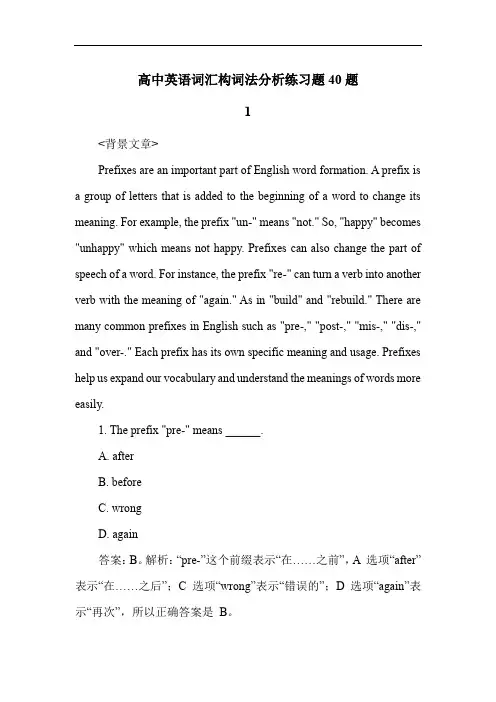
高中英语词汇构词法分析练习题40题1<背景文章>Prefixes are an important part of English word formation. A prefix is a group of letters that is added to the beginning of a word to change its meaning. For example, the prefix "un-" means "not." So, "happy" becomes "unhappy" which means not happy. Prefixes can also change the part of speech of a word. For instance, the prefix "re-" can turn a verb into another verb with the meaning of "again." As in "build" and "rebuild." There are many common prefixes in English such as "pre-," "post-," "mis-," "dis-," and "over-." Each prefix has its own specific meaning and usage. Prefixes help us expand our vocabulary and understand the meanings of words more easily.1. The prefix "pre-" means ______.A. afterB. beforeC. wrongD. again答案:B。
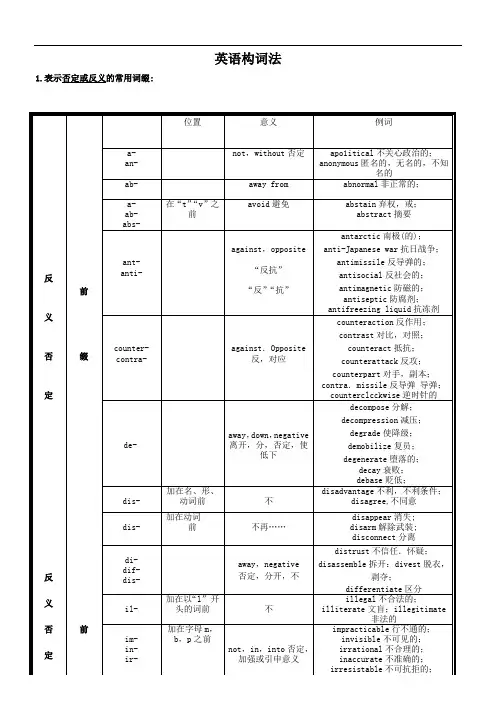
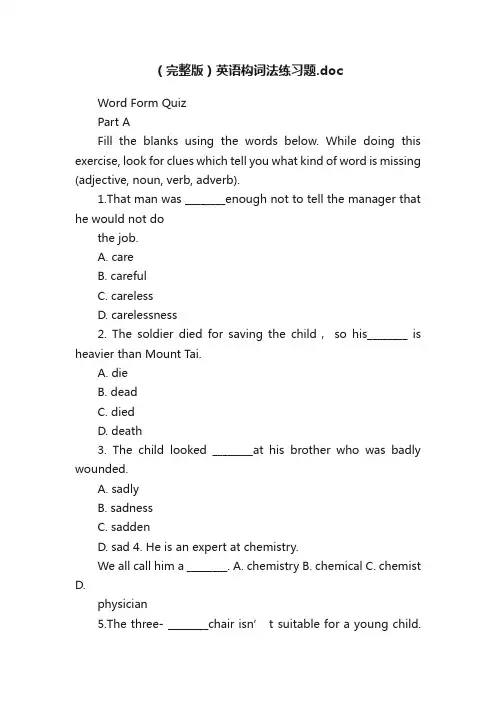
(完整版)英语构词法练习题.docWord Form QuizPart AFill the blanks using the words below. While doing this exercise, look for clues which tell you what kind of word is missing (adjective, noun, verb, adverb).1.That man was ________enough not to tell the manager that he would not dothe job.A. careB. carefulC. carelessD. carelessness2. The soldier died for saving the child,so his________ is heavier than Mount Tai.A. dieB. deadC. diedD. death3. The child looked ________at his brother who was badly wounded.A. sadlyB. sadnessC. saddenD. sad 4. He is an expert at chemistry.We all call him a ________. A. chemistry B. chemical C. chemist D.physician5.The three- ________chair isn’ t suitable for a young child.He may fall off.A. leggingB. leggedC. legsD. leged6. Stephenson became the________railway engineer in the world.A. leadB. leaderC. leadingD. leadership7.When the teacher praised him for working out the maths problem , Jack looked________about at his classmates.A. proudB. proudlyC. prideD. pridely8.To everyone ’ s , the girl finished the job quite well.A. satisfiedB. satisfactoryC. satisfyingD. satisfaction9.—What are you doing here?—Oh,my teacher asked me to write a passage about ________in English.—You can write________passage in English?A.600 words; a 600-wordsB.600-word;a 600-wordsC.600 words;a 600-wordD.600 words; a 600-words10. No one should enter the spot without the________of the police.A. permitB. permissionC. permittingD. permittence11. You must come with us to the police ________.Our head is waiting for you.A. headquartersB. headlineC. headmasterD.headache12.Letting that animal escape was no accident;you did it ________.A. intendB. intentionC. intentionallyD. intentional13. The shop owner welcomed all the guests with a________smile.A. practiceB. practiseC. practicalD. practiced14. The________ordered him to pay a $100 fine.A. judgerB. judgmentC. judgeD. judgement15. My TV is out of order. Can you tell me what is the________news about Iraq War?A. latelyB. latestC. laterD. latter16. The Great Wall is more than 6000 li in ________.A. longerB. lengthC. longD. longing17.To my ________,I passed the exam easily.A. joyB. joyfulC. joylessD. joyness18. Canada is mainly an________country.A. English-speakingB. speak-EnglishC. spoken-EnglishD. English-spoken19.How________ he is! He is always acting________.He is reallya ________.A. foolish; foolishly; foolB. fool;foolish;foolC. foolish; fool ;foolD. foolishly; foolish;fool20. The necklace that she lost is very expensive. It’ s of great ________.A. valuableB. valueC. valuelessD. unvaluable21. There were________fish in the river in South America.A. in dangerB. dangerC. dangerousD. dangerless22.The letter“ b” in the word“ doubt” is________.A. soundB. silentC. silenceD. sounded23. The child looked at me________.A. strangerB. strangelyC. strangeD. strangeless24.The black people were against slavery and fought for their________bravely.A. freeB. freelyC. freedomD. frees25. What you said sounded________ but in fact it was untrue.A. reasonableB. reasonfulC. reasonlessD. unreason26. We have to learn ________technology from other countries.A. advanceB. advancingC. advantageD. advanced27. The children live in a village ________.They come here almost every day.A. nearbyB. nearC. nearlyD. near by28.Mr Black is an ________in the army,not an ________in the government. You can not easily find him in his________.A.official; officer;officeB.officer;office; officialC.official; official;officialD.officer; official;office29.You ’ d better give up smoking if you want to keep________. A. health B. healthy C. healthily D. healthier30.________ speaking,I didn ’ t do it on purpose. A.Honestly B. Honest C. HonestyD. DishonestPart BUse the word at the end of each gap to form a new word with which to fill the gap. While doing this exercise, look for clues which tell you what kind of word is missing (adjective, noun, verb, adverb). Make sure to take into consideration forms using various prefixes and suffixes, as well as negative forms.We earn our_____________ (LIVE) in America today in peaceful ____________ (COMPETE)with people all across the Earth. Profound and _________ (POWER) forces are shaking and _________ (MAKE)our world, and the urgent question of our time is whether we can make change our friend and not our enemy. This new world has already ___________ (RICH) the lives of millions of Americans who are able to____________ (COMPETITION)and win in it. But when most people are working harder for less, when others cannot work at all, when the cost of health care devastates families and threatens to ____________ (BANK) our enterprises, great and small, when the fear of crime robs law abiding citizens of their _____________ (FREE),and when millions of poor children cannot even imagine the lives we are calling them to lead, we have not made change our friend.Some Tips1. V-ing 和V-ed 作形容词时的差别表示情感的及物如excite, discourage, disappoint, encourage, inspire, interest, move, please, puzzle, surprise, worry 等,其分常加上后-ing 或 -ed 化分(也可称形容),用作表、定、状或。
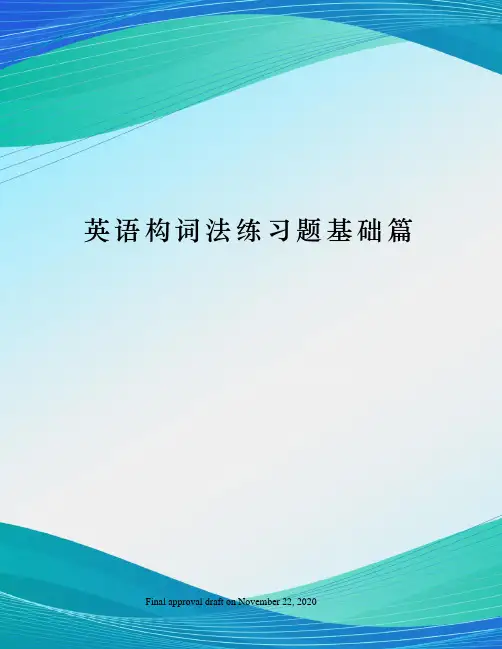
英语构词法练习题基础篇 Final approval draft on November 22, 2020英语构词法练习题一、基础练习A: 名词后加“y”变成形容词sun---_________( ) wind ---__________( ) cloud ---__________( )rain ---________( ) snow ---__________( ) fun---__________( )health ---________( ) noise ---__________( ) salt---__________( )luck ---__________( ) sleep ---__________( ) sand ---__________( )B: 名词后加“-ful” “-less”变成形容词care ---__________( )__________( ) use---__________( )__________( )colour---__________( ) _________( ) help---__________( ) __________( )hope ---__________( )__________( ) harm ---__________( ) __________( )success---________( ) wonder---_______( ) peace---__________( )sleep ---__________( ) home---__________( ) value---__________( )C: 名词后加“-ern”变成形容词east---______( )west ---_______( )south---_______( ) north---__________( )D: 名词后加“-al”变成形容词person---__________( )education---__________( )tradition---__________( ) medicine---__________( ) music ---__________( ) nature---__________( )E: 名词后加“-ly”变成形容词friend---___________( ) love---___________( ) week---__________( )F: 名词后加“--ous”变成形容词danger---___________( ) mystery---___________( ) fame---__________( )G: 名词后加“-en”变成形容词wool---___________( ) wood---___________( ) gold---__________( )H: 名词转化为形容词的不规则变化energy---___________( ) athlete---___________( ) hunger---___________( ) pride---___________( ) death---___________( ) science---___________( )knowledge---___________( ) anger---___________( ) Africa---___________( ) America---___________( ) Asia---___________( ) Australia---___________( )I:动词变名词①work---________(工作者) sing---________(歌手) teach---_________(教师) drive---_________(司机) write---________(作家) dance---_________(舞蹈家)win---_________(获胜者) run---___________(赛跑者) swim---_________(游泳者)act---_________(演员) collect---__________(收藏家) direct---___________(主管)visit---_________(参观者) invent---_________(发明家) translate---_______ _(翻译家)②educate---___________(教育) describe---___________(描述) predict---___________(预言)collect---___________(收藏) invent---___________(发明) build---___________(建筑物)③mean---___________(意思) meet---___________(会议) cross---___________(路口)turn---___________(转弯处) decide---___________(决定) die---___________(死亡) ④fly---___________(飞行) know---___________(知识) please---___________(高兴)pronounce---___________(发音) mix---___________(混合物)J:形容词的两种形式—ing/—edplease---___________(令人高兴的)---___________(感到高兴的)surprise---___________(令人惊讶的的) ---___________(感到惊讶的)excite---___________(令人兴奋的) ---___________(感到兴奋的)interest---___________(令人感兴趣的)---___________( 感兴趣的)worry---___________(令人担忧的) ---___________(感到担忧的)amaze, annoy, bore, disappoint, embarrass, frustrate, relax, terrify, thrill, tire等K: 形容词的变化a: 形容词变副词。
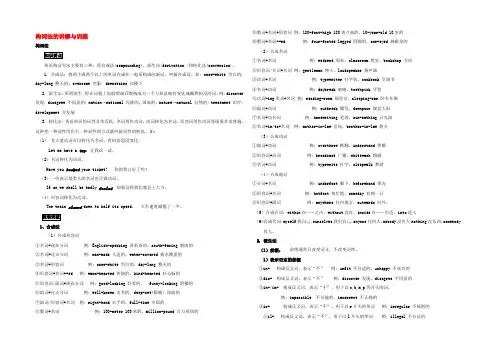
构词法的讲解与训练构词法英语构词方法主要有三种:即合成法(compounding)、派生法(derivation )和转化法(conversion)。
1. 合成法:将两个或两个以上的单词合成在一起而构成的新词,叫做合成词。
如:snow-white 雪白的;day-long 整天的;overcome 克服;downstairs 在楼下2. 派生法:所谓派生,即在词根上加前缀或后缀构成另一个与原意略有变化或截然相反的词。
例:discover 发现;disagree 不同意的;nation→national 民族的,国家的;nature→natural 自然的;treatment 治疗;development 开发展3. 转化法:英语单词的词性非常活跃,名词用作动词,动词转化为名词,形容词用作动词等现象非常普遍,这种把一种词性用作另一种词性的方式就叫做词性的转化。
如:(1)有大量动词可以转化为名词,有时意思没变化。
Let me have a try. 让我试一试。
(2)名词转化为动词。
Have you booked your ticket? 你的票订好了吗?(3)一些表示某类人的名词也可做动词。
If so,we shall be badly fooled. 如果这样我们就会上大当。
(4)形容词转化为动词。
The train slowed down to half its speed. 火车速度减慢了一半。
1、合成法(1)合成形容词①名词+现在分词例:English-speaking 讲英语的,south-facing 朝南的②名词+过去分词例:man-made 人造的,water-covered 被水覆盖的③名词+形容词例:snow-white 雪白的,day-long 整天的④形容词+名词+-ed 例:warm-hearted 热情的,kind-hearted 好心肠的⑤形容词/副词+现在分词例:good-looking 好看的,funny-looking 滑稽的⑥副词+过去分词例:well-known 出名的, deep-set(眼睛)深陷的⑦副词/形容词+名词例:right-hand 右手的,full-time 专职的⑧数词+名词例:100-meter 100米的,million-pound 百万英镑的⑨数词+名词+形容词例:180-foot-high 180英寸高的,10-year-old 10岁的⑩数词+名词+-ed 例:four-footed/legged 四脚的,one-eyed 独眼龙的(2)合成名词①名词+名词例:weekend 周末,classroom 教室,bookshop 书店②形容词/介词+名词例:gentleman 绅士,loudspeaker 扬声器③动词+名词例:typewriter 打字机,cookbook 烹调书④名词+动词例:daybreak 破晓,toothpick 牙签⑤动词-ing形式+名词例:reading-room 阅览室,sleeping-car 卧车车厢⑥副词+动词例:outbreak 爆发,downpour 倾盆大雨⑦名词+动名词例:handwriting 笔迹,sun-bathing 日光浴⑧名词+in/to+名词例:mother-in-law 岳母,brother-in-law 姐夫(3)合成动词①副词+动词例:overthrow 推翻,understand 理解②形容词+动词例:broadcast 广播,whitewash 粉刷③名词+动词例:typewrite 打字,sleepwalk 梦游(4)合成副词①介词+名词例:underfoot 脚下,beforehand 事先②形容词+名词例:hotfoot 匆忙地,someday 有朝一日③形容词+副词例:anywhere 任何地方,outwards 向外、(5)合成介词:within在……之内,without没有,inside在……里边,into进入(6)合成代词:myself我自己,ourselves我们自己,anyone任何人,nobody没有人nothing没东西,somebody 有人。
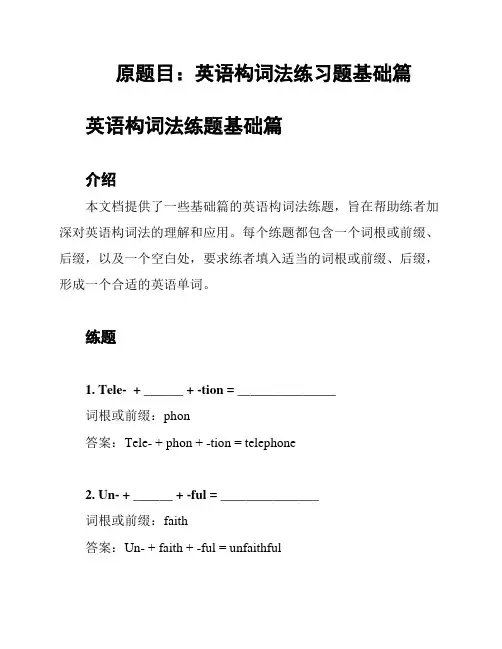
原题目:英语构词法练习题基础篇英语构词法练题基础篇介绍本文档提供了一些基础篇的英语构词法练题,旨在帮助练者加深对英语构词法的理解和应用。
每个练题都包含一个词根或前缀、后缀,以及一个空白处,要求练者填入适当的词根或前缀、后缀,形成一个合适的英语单词。
练题1. Tele- + ______ + -tion = _______________词根或前缀:phon答案:Tele- + phon + -tion = telephone2. Un- + ______ + -ful = _______________词根或前缀:faith答案:Un- + faith + -ful = unfaithful4. Bi- + ______ + -lingual = _______________词根或前缀:lingua答案:Bi- + lingua + -lingual = bilingual5. In- + ______ + -ly = _______________词根或前缀:visible答案:In- + visible + -ly = invisibly6. Mis- + ______ + -er = _______________词根或前缀:lead答案:Mis- + lead + -er = misleader7. ______ + -ed + -ing = interestingly词根或前缀:interest答案:Interest + -ed + -ing = interestingly8. En- + ______ + -ment = _______________词根或前缀:slave答案:En- + slave + -ment = enslavement9. Over- + ______ + -ize = _______________词根或前缀:sensitize答案:Over- + sensitize + -ize = oversensitize10. ______ + -able + -ly = agreeably词根或前缀:agree答案:Agree + -able + -ly = agreeably总结本文档提供了一些基础篇的英语构词法练习题,通过填写适当的词根或前缀、后缀,可以形成一个合适的英语单词。
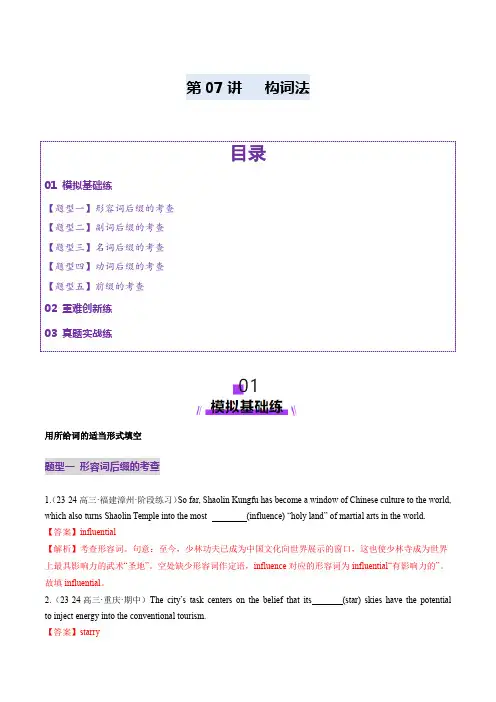
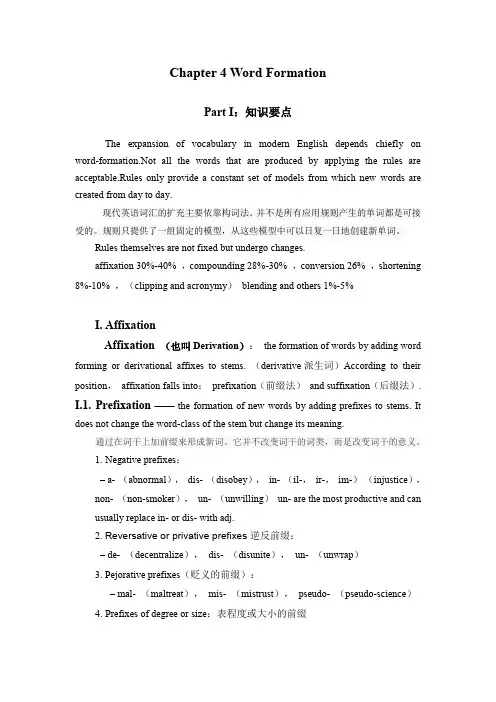
Chapter 4 Word FormationPart I:知识要点The expansion of vocabulary in modern English depends chiefly on word-formation.Not all the words that are produced by applying the rules are acceptable.Rules only provide a constant set of models from which new words are created from day to day.现代英语词汇的扩充主要依靠构词法。
并不是所有应用规则产生的单词都是可接受的。
规则只提供了一组固定的模型,从这些模型中可以日复一日地创建新单词。
Rules themselves are not fixed but undergo changes.affixation 30%-40% ,compounding 28%-30% ,conversion 26% ,shortening 8%-10% ,(clipping and acronymy)blending and others 1%-5%I. AffixationAffixation (也叫Derivation):the formation of words by adding word forming or derivational affixes to stems. (derivative派生词)According to their position,affixation falls into:prefixation(前缀法)and suffixation(后缀法).I.1. Prefixation—— the formation of new words by adding prefixes to stems. It does not change the word-class of the stem but change its meaning.通过在词干上加前缀来形成新词。
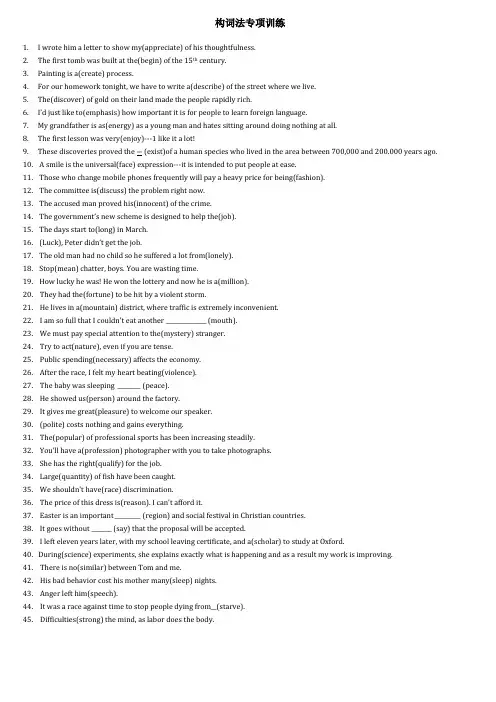
构词法专项训练1.I wrote him a letter to show my(appreciate) of his thoughtfulness.2.The first tomb was built at the(begin) of the 15th century.3.Painting is a(create) process.4.For our homework tonight, we have to write a(describe) of the street where we live.5.The(discover) of gold on their land made the people rapidly rich.6.I’d just like to(emphasis) how important it is for people to learn foreign language.7.My grandfather is as(energy) as a young man and hates sitting around doing nothing at all.8.The first lesson was very(enjoy)---1 like it a lot!9.These discoveries proved the ― (exist)of a human species who lived in the area between 700,000 and 200.000 years ago.10. A smile is the universal(face) expression---it is intended to put people at ease.11.Those who change mobile phones frequently will pay a heavy price for being(fashion).12.The committee is(discuss) the problem right now.13.The accused man proved his(innocent) of the crime.14.The government’s new scheme is designed to help the(job).15.The days start to(long) in March.16.(Luck), Peter didn’t get the job.17.The old man had no child so he suffered a lot from(lonely).18.Stop(mean) chatter, boys. You are wasting time.19.How lucky he was! He won the lottery and now he is a(million).20.They had the(fortune) to be hit by a violent storm.21.He lives in a(mountain) district, where traffic is extremely inconvenient.22.I am so full that I couldn't eat another ______________ (mouth).23.We must pay special attention to the(mystery) stranger.24.Try to act(nature), even if you are tense.25.Public spending(necessary) affects the economy.26.After the race, I felt my heart beating(violence).27.The baby was sleeping ________ (peace).28.He showed us(person) around the factory.29.It gives me great(pleasure) to welcome our speaker.30.(polite) costs nothing and gains everything.31.The(popular) of professional sports has been increasing steadily.32.You’ll have a(profession) photographer with you to take photographs.33.She has the right(qualify) for the job.rge(quantity) of fish have been caught.35.We shouldn't have(race) discrimination.36.The price of this dress is(reason). I can't afford it.37.Easter is an important _________ (region) and social festival in Christian countries.38.It goes without _______ (say) that the proposal will be accepted.39.I left eleven years later, with my school leaving certificate, and a(scholar) to study at Oxford.40.During(science) experiments, she explains exactly what is happening and as a result my work is improving.41.There is no(similar) between Tom and me.42.His bad behavior cost his mother many(sleep) nights.43.Anger left him(speech).44.It was a race against time to stop people dying from__(starve).45.Difficulties(strong) the mind, as labor does the body.46. A positive outlook is vital to dealing(success) with the crisis in adolescence and old age in our life.47.It is a colorless, odorless and(taste) gas, slightly heavier than air.48.He knew he had behaved badly and he seemed(true) sorry.49.This wounded soldier was(conscious) from his loss of blood.50.It’s(believe) that the event repeated itself years later in the same place.51.Overpopulation is a(universe) problem.52.More and more people choose to shop in a supermarket as it offers a great (vary) of goods.53.The(arrive) of migrant workers into the capital had seen Beijing’s population reach 17.4 million.54.Besides, many newspapers are printed daily and can offer the readers(rely) information.55.Girls make up only a small(percent) of students in computer science classes.56.I live in Hollywood. You may think people in such an ________________ (attract), fun-filled place are happier than others.Maybe that is because you haven’t noticed the(happy) they’ve concealed from you.57.In 2006, Taipei Zoo applied to host the pandas, Tuantuan and Yuanyuan, from the mainland. But the Taiwan government didn'tallow their(apply).58.Firstly, it(able) the Chinese people to know more about the outside world and promote(friend) and mutual understanding.59.Loss and(separate) are often what you find behind a child acting out in school.60.By saving money, people give themselves more(secure).61.Star sapphires and other(value) jewels worth a total of one million dollars are on show behind glass.62.If time could be turned back, allow me to take you back to December 26, 2004,(tradition), it is a time for family gathering, a timefor(celebrate).63.Because of the(popular) of TV and computers, they are getting much less exercise than before.64.“I would have no(object),”said the wolf, “if I could only get a place.”65.Some people have the feeling that nothing can be done about their poor reading(able).66.An ounce of luck is better than a pound of(wise).67.Researchers in Italy examined the tail wagging(behave) of 30 dogs.68.Another(convenience) feature of the EOL is that you'll be able to pick the level of detail you want to see to match your interested,age, and knowledge.69.Health problems are(close) connected with bad eating habits and a lack of exercise.70.You may(like) some types of food because they do not look, smell or taste very nice.71.What is more, it is true that computers can make(decide), but they need detailed instructions and programs prepared by humans tooperate.72.Then they chose three Broadway tunes that focused on race,(equal) and social justice, the themes of the book.73.As I lined up for the start I glanced at the flag. It moved __________________ (gentle) now.74.Some people have the feeling that nothing can be done about their poor reading ability. They feel (hope) about it.75.An important new study into teenage attitudes surprisingly shows that their family life is more (harmony) than it has ever been inthe past.76.The(inform) gained helped up in determining where special attention should be paid in our course.77.In the following account, she recalls the job that challenged her(imagine) and skill but left her flying high.78. A thousand words will not leave so deep an(impress) as one deed.79.And I included only those books over a hundred pages in(long).80.Keep your eyes wide open before(marry), and half shut afterwards.81.Reading comprehension can’t be(dependent) from the knowledge of writing.82.(music) often called him Pops, as a sign of respect for his influence on the world of music.83.The northern city of Turin passed a law in April to give pet(own) fines of up to $598 if they do not walk their dogs three times aday.84.So far, scientists have named about 1.8 million living species, and that’s just a small number of what(probable) exists on Earth.85.Men can do nothing without its _________________ (permit), and it fastens its young round people’s wrists so thateverywhere men go they are still under its control.86.The best(prepare) for good work tomorrow is to do good work today.87.He answered me(rude) and said he would not come back.88.As his university was aware of the(significant) of his work, they gave him free time to do this research.89.Cuzco is a lively city where both Indian and(Spain) culture and are can be seen.90.The best time to visit New Zealand is from November to April---summer time in the (south) hemisphere.91.Jo went to New York and became(succeed) in her writing and had the(satisfy) of seeing her work published there.92.(like) other camp programs that include horses as a small part of their program, at Shadow Ridge horses are the program!93.The smell is, as usual, almost(bear), being a mixture of sweat and dirty underwear.英语构词通常包括六种方法:转化法、派生法、合成法、混合法、截短法和首尾字母结合法。
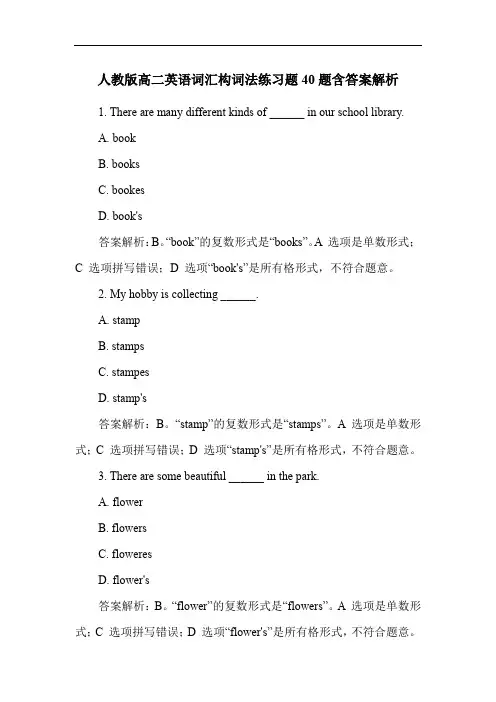
人教版高二英语词汇构词法练习题40题含答案解析1. There are many different kinds of ______ in our school library.A. bookB. booksC. bookesD. book's答案解析:B。
“book”的复数形式是“books”。
A 选项是单数形式;C 选项拼写错误;D 选项“book's”是所有格形式,不符合题意。
2. My hobby is collecting ______.A. stampB. stampsC. stampesD. stamp's答案解析:B。
“stamp”的复数形式是“stamps”。
A 选项是单数形式;C 选项拼写错误;D 选项“stamp's”是所有格形式,不符合题意。
3. There are some beautiful ______ in the park.A. flowerB. flowersC. floweresD. flower's答案解析:B。
“flower”的复数形式是“flowers”。
A 选项是单数形式;C 选项拼写错误;D 选项“flower's”是所有格形式,不符合题意。
4. I like playing ______.A. basketballB. the basketballC. a basketballD. basketballs答案解析:A。
“play basketball”是固定搭配,中间不加冠词。
B 选项和C 选项错误;D 选项“basketballs”虽然语法上没错,但此处表达的是喜欢打篮球这项运动,而不是具体的多个篮球。
5. My sister is good at playing the ______.A. pianoB. pianosC. pianoesD. piano's答案解析:A。
“play the piano”是固定搭配,乐器前面要加定冠词“the”。
人教版高二英语词汇构词法练习题30题【含答案解析】1.The teacher's words were very _______(encourage).A.encouragementB.encouragedC.encouragingD.encourage答案解析:C。
选项A“encouragement”是名词形式,“鼓励”;选项B“encouraged”一般修饰人,表示“受到鼓舞的”;选项C“encouraging”修饰物,表示“令人鼓舞的”;题干中说老师的话是令人鼓舞的,修饰words 用“encouraging”。
选项D“encourage”是动词形式,“鼓励”。
2.We need to make our city more _______(beauty).A.beautifulB.beautifullyC.beautifyD.beautiness答案解析:A。
选项A“beautiful”是形容词形式,“美丽的”;选项B“beautifully”是副词形式,“美丽地”;选项C“beautify”是动词形式,“美化”;选项 D 拼写错误。
题干中说让城市更美丽,用形容词“beautiful”。
3.The news was very _______(surprise).A.surprisedB.surprisingC.surpriseD.surprisingly答案解析:B。
选项A“surprised”一般修饰人,表示“感到惊讶的”;选项B“surprising”修饰物,表示“令人惊讶的”;选项C“surprise”是名词和动词形式,“惊讶”;选项D“surprisingly”是副词形式,“令人惊讶地”。
题干中说消息令人惊讶,修饰news 用“surprising”。
4.She has a very _______(act) lifestyle.A.actB.actionC.activeD.actively答案解析:C。
英语构词法练习题初三一、词根词缀1. 在下列单词中,找出含有相同词根的一组。
a) descriptionb) prescribec) ascertaind) inscribe2. 在下列单词中,找出前缀和后缀的组合。
a) misunderstandingb) reorganizec) plentifuld) disagreement3. 在下列单词中,找出含有相同词缀的一组。
a) importantb) carefulc) hopefuld) childish二、构词法根据所给的词根、前缀或后缀,构造新的单词。
1. 词根:graph构造一个带有该词根的单词,并解释其意思。
2. 前缀:un-构造一个带有该前缀的单词,并解释其意思。
3. 后缀:-able构造一个带有该后缀的单词,并解释其意思。
4. 词根:bio-构造一个带有该词根的单词,并解释其意思。
5. 前缀:dis-构造一个带有该前缀的单词,并解释其意思。
6. 后缀:-ful构造一个带有该后缀的单词,并解释其意思。
7. 词根:tele-构造一个带有该词根的单词,并解释其意思。
8. 前缀:pre-构造一个带有该前缀的单词,并解释其意思。
9. 后缀:-er构造一个带有该后缀的单词,并解释其意思。
三、词类转换根据所给的词性,将下列词语转换成不同的词类。
1. 名词 -> 动词a) distanceb) decision2. 名词 -> 形容词a) natureb) youth3. 动词 -> 名词a) inventb) progress4. 动词 -> 形容词a) exploreb) expand5. 形容词 -> 名词a) peacefulb) beautiful6. 形容词 -> 动词a) ancientb) mysterious四、派生词选择选择合适的派生词填空。
1. The novel was ________ by a famous author. (write)a) writtenb) writingc) wroted) writes2. The ________ of the new computer game was impressive. (develop)a) developerb) developmentc) developd) developing3. The actress's performance was ________. (amaze)a) amazingb) amazedc) amazementd) amazes4. The boy was ________ with his excellent grades. (please)a) pleasureb) pleasedc) pleasingd) please5. The ________ of the painting was on display at the museum. (create)a) creationb) creativec) createsd) creating充分运用英语构词法,灵活创建新的单词,并熟练进行词类转换和选择合适的派生词,对于初三学生来说是提高词汇运用能力的重要练习内容。
构词法一.概念英语的构词法主要有:转化法,合成法,派生法,混合法,截短法和首尾字母缩略法。
二.知识点精讲1.转化法英语中,有的名词可作动词,有的形容词可作副词或动词,这种把一种词性用作另一种词性而词形不变的方法叫作转化法。
1)动词转化为名词2)名词转化为动词3)形容词转化为动词有少数形容词可以转化为动词。
如:We will try our best to better our living conditions.我们要尽力改善我们的生活状况。
4)副词转化为动词有少数副词可以转化为动词。
例如:Murder will out.(谚语)恶事终必将败露。
5)形容词转化为名词①表示颜色的形容词常可转化为名词,如:You should be dressed in black at the funeral.你在葬礼中该穿黑色衣服②某些形容词如old, young, poor, rich, wounded, injured等与the连用,表示一类人,作主语时,谓语用复数如下,如:The old in our village are living a happy life.我们村的老年人过着幸福的生活。
2.派生法在词根前面加前缀或在词根后面加后缀构成一个与原单词意义相近或截然相反的新词叫作派生法。
1)前缀除少数前缀外,前缀一般改变单词的意义,不改变词性;后缀一般改变词类,而不引起词义的变化。
(1)表示否定意义的前缀常用的有dis-, il-, im-, in-, ir-, mis-, non-, un-等,在单词的前面加这类前缀常构成与该词意义相反的新词。
例如:appear出现→disappear消失correct正确的→incorrect不正确的lead带领→mislead领错stop停下→non-stop不停(2)表示其他意义的前缀常用的有a-(多构成表语形容词), anti- (反对;抵抗), auto- (自动), co- (共同), en- (使), inter- (互相), re- (再;又), sub- (下面的;次;小), tele- (强调距离)等。
1、An _____must take _____lessons.【选项】A. actor; actB. actor; actingC. acting; actorD. acting; actB由题意来看,“演员必须上表演课”,actor 为名词;take acting lessons 为固定短语。
2、 ----Do you know the result of the ________race?----Yes. The winner is a boy ________Lin Feng from Class 4.A.100-metres, calledB.100-metre; callingC.100-metre; calledD.100-metres, calling【答案】C【解析】试题分析:句意为:---你知道 100米比赛的结果吗?---知道。
获奖者是来自 4班的叫林峰的男孩。
连字符号连接数词和名词,相当于形容词,这时名词不用复数形式。
分词短语作后置定语,ed 形式表示被动意义,ing 形式表示主动意义。
结合语境可知应选 C。
考点:考查形容词的用法。
3、– Is there a bridge over the river?– Yes, there is ______bridge over it.A.a 800-metres-longB.an 800-metres-longC.a 800-metre-longD.an 800-metre-long【答案】D【解析】试题分析:句意为:---河面上有一座桥吗?---有。
河面上有一条800米长的桥。
连字符号连接数词、名词,和形容词,用作形容词,这时名词不用复数形式。
a 用于辅音发音开头的词前, an 用于元音发音开头的词前。
eight 读作/eit/,故选 D。
考点:考查冠词的用法。
4、There are many shops on ______side of the busy street.A.everyB.eachC.bothD.all【答案】B【解析】试题分析:句意:在繁华的街道上的两边有许多商店。
高中英语词汇构词法分析练习题50题1. My brother is a bookworm. He loves to read in his free time. The underlined word “bookworm” is a(an) _____.A.noun + nounB.verb + nounC.adjective + nounD.adverb + noun答案:A。
“bookworm”由“book(书)”和“worm(虫子)”两个名词组成,是一个合成词,意思是“书呆子”。
选项 A 是名词加名词;选项B 是动词加名词;选项C 是形容词加名词;选项D 是副词加名词。
2. The blackboard is very important in the classroom. The underlined word “blackboard” is a(an) _____.A.noun + nounB.verb + nounC.adjective + nounD.adverb + noun答案:A。
“blackboard”由“black( 黑色的)”和“board( 板)”两个名词组成,是一个合成词,意思是“黑板”。
选项 A 是名词加名词;选项B 是动词加名词;选项C 是形容词加名词;选项D 是副词加名词。
3. The firefighter is very brave. He saves people from fire. Theunderlined word “firefighter” is a(an) _____.A.noun + nounB.verb + nounC.adjective + nounD.adverb + noun答案:A。
“firefighter”由“fire( 火)”和“fighter( 战士)”两个名词组成,是一个合成词,意思是“消防员”。
选项 A 是名词加名词;选项B 是动词加名词;选项C 是形容词加名词;选项D 是副词加名词。
英语必修五构词法练习题英语构词法是学习英语词汇的重要工具之一,它能帮助我们更好地理解和记忆单词。
以下是一些英语必修五构词法的练习题,供学生练习使用。
一、前缀和后缀练习1. 给下列单词添加适当的前缀或后缀,使其成为新词,并解释新词的含义。
- happy → _unhappy_(不快乐的)- possible → _impossible_(不可能的)- agree → _disagree_(不同意)2. 将下列单词的前缀或后缀去掉,解释原词的含义。
- unhappy → _happy_(快乐的)- impossible → _possible_(可能的)- disagree → _agree_(同意)3. 根据所给的词根和前缀或后缀,构造新词。
- "act" + "ive" → _active_(积极的)- "un" + "usual" → _unusual_(不寻常的)- "re" + "build" → _rebuild_(重建)二、合成词练习1. 将下列单词组合成合成词,并解释其含义。
- sun + rise → _sunrise_(日出)- class + room → _classroom_(教室)- full + time → _full-time_(全职的)2. 给下列合成词添加适当的前缀或后缀,使其成为新词,并解释新词的含义。
- sunrise → _sunset_(日落)- classroom → _classroom-based_(基于教室的)- full-time → _part-time_(兼职的)三、派生词练习1. 给下列单词添加派生词后缀,使其成为名词或形容词。
- act → _action_(行动)- believe → _belief_(信念)- organize → _organization_(组织)2. 将下列派生词还原成原词,并解释其含义。
英语构词法练习题一、基础练习A: 名词后加“y”变成形容词sun---_________( ) wind ---__________( ) cloud ---__________( )rain ---________( ) snow ---__________( ) fun---__________( )health ---________( ) noise ---__________( ) salt---__________( )luck ---__________( ) sleep ---__________( ) sand ---__________( )B: 名词后加“-ful” “-less”变成形容词care ---__________( )__________( ) use---__________( )__________( ) colour---__________( ) _________( ) help---__________( ) __________( ) hope ---__________( )__________( ) harm ---__________( ) __________( ) success---________( ) wonder---_______( ) peace---__________( )sleep ---__________( ) home---__________( ) value---__________( )C: 名词后加“-ern”变成形容词east---______( )west ---_______( )south---_______( ) north---__________( ) D: 名词后加“-al”变成形容词person---__________( )education---__________( )tradition---__________( ) medicine---__________( ) music ---__________( ) nature---__________( ) E: 名词后加“-ly”变成形容词friend---___________( ) love---___________( ) week---__________( )F: 名词后加“--ous”变成形容词danger---___________( ) mystery---___________( ) fame---__________( )G: 名词后加“-en”变成形容词wool---___________( ) wood---___________( ) gold---__________( )H: 名词转化为形容词的不规则变化energy---___________( ) athlete---___________( ) hunger---___________( ) pride---___________( ) death---___________( ) science---___________( ) knowledge---___________( ) anger---___________( ) Africa---___________( ) America---___________( ) Asia---___________( ) Australia---___________( ) I:动词变名词①work---________(工作者) sing---________(歌手) teach---_________(教师) drive---_________(司机) write---________(作家) dance---_________(舞蹈家)win---_________(获胜者) run---___________(赛跑者) swim---_________(游泳者)act---_________(演员) collect---__________(收藏家) direct---___________(主管) visit---_________(参观者) invent---_________(发明家) translate---_______ _(翻译家)②educate---___________(教育) describe---___________(描述) predict---___________(预言)collect---___________(收藏) invent---___________(发明) build---___________(建筑物)③mean---___________(意思) meet---___________(会议) cross---___________(路口)turn---___________(转弯处) decide---___________(决定) die---___________(死亡)④fly---___________(飞行) know---___________(知识) please---___________(高兴)pronounce---___________(发音) mix---___________(混合物)J:形容词的两种形式—ing/—edplease---___________(令人高兴的)---___________(感到高兴的)surprise---___________(令人惊讶的的) ---___________(感到惊讶的)excite---___________(令人兴奋的) ---___________(感到兴奋的)interest---___________(令人感兴趣的)---___________( 感兴趣的)worry---___________(令人担忧的) ---___________(感到担忧的)amaze, annoy, bore, disappoint, embarrass, frustrate, relax, terrify, thrill, tire等K: 形容词的变化a: 形容词变副词。
quick---____________( ) strong---____________( ) heavy---____________( ) angry---____________( ) lucky---____________( ) healthy---____________( ) noisy---____________( ) usual---____________( ) careful---__________( ) successful---_________( ) terrible---___________( ) possible---____________( ) b: 形容词变名词。
Kind---____________( )happy---____________( )ill---____________( ) safe---____________( )confident---____________( )important---____________( ) different---____________( )true---____________( ) high---____________( ) 二、高考真题训练1).用所给词的正确形式填空。
1.It is ________ (legal)to drive after drinking alcohol.2.The Chinese people are very ________ (friend)to foreigners.3.David moved ________ (caution)forward.4.The teacher gave them ________ (instruct)to arrive early tomorrow morning.5.Three people have been killed in a bomb ________(explode)in northwest Spain.6.One should have the ability to tell the ________(different)between right and wrong.7.He is a ________ (quality)teacher who is respected by his students.8.For many Americans the automobile is a ________(necessary).9.Excessive dosage(剂量)of this drug can result in ________(injure)to the liver.10.“Thank you.” is a polite ________ (express)which is widely used in English.2).改错练习。
1.The Milu deer are living in the wild in a natural park.2.This blouse is fit for him at all. It’s too long and the color has run.3.The possibly that the majority of the labor force will work at home is often discussed.4.We must strength government of the people,by the people and for the people.5.The sperm whale can dive to a deep of more than 1000 meters in the sea.6.He is a very famous actress. He has played many important parts in different films.7.Personal,I’d rather stay at home watching TV.8.Because of her ill,she can’t go out for the sight-seeing.9.Thank you for your describe of the conditions here.10.It’s really dust in this room. It’s a long time since someone last lived in it.。